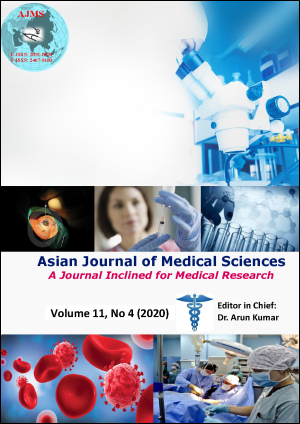In-Silico structural analysis of wild-type human hemoglobin and its mutation resulting in sickle cell anemia
Keywords:
HbA, HbS, sickle cell anemia, In-silicoAbstract
Background: Hemoglobin (HbA) is a metalloprotein having a heme prosthetic group, two α-globin chains, and two β-globin chains. A point mutation in the 6th position of wild-type HBB gene (GAG>GTG) substitutes Glutamic acid (E) to Valine (V) in the β-chains of hemoglobin molecule (HbS) resulting in Sickle Cell Anemia. Structural deformities in the β-globin gene leads to disruptive conformation of red blood cells, disturbs the oxygen transportation and causes functional abnormalities.
Aims and Objective: The purpose of the study was to understand the structural, genetic and metabolic effect of the point mutation on HBB gene that causes sickle cell disease.
Materials and Methods: The 3D structures of HbA and HbS proteins were retrieved from PDB and the changes in their physical properties were analyzed using Swiss PDB viewer and Molegro molecule viewer. Gene networks were constructed using GeneMANIA server to study genetic and metabolic interactions of the HBB gene.
Results: In-silico studies showed that the normal bond length between Glu6-Glu7 in HbA molecule is 1.32Å and that of HbS is 1.33Å. After comparing the two proteins, it was observed that sickle cell hemoglobin suffers a change in bond angle from 122.4º in HbA to 119.35º in HbS. Comparative energy minimization of Glu6 and Val6 in wild-type and mutant hemoglobin respectively yielded 8.78 and -9.083 KJ/mol net energy values, suggesting a more reactive HbA and less reactive HbS. Gene networks were determined on the basis of physical, genetic and co-expressive interactions of HBB gene which revealed a strong connection between HBB and HBA1 genes within the association constituted of various metabolic functions.
Conclusion: Sickle cell disease results from a sequence of events which start with a single nucleotide substitution that ultimately leads to severe anemia and other cardiovascular problems. Incorporation of computational exercises correlates to a better probability of discovering precision medicine through target site-specific drug designing.
Downloads
Downloads
Published
How to Cite
Issue
Section
License
Authors who publish with this journal agree to the following terms:
- The journal holds copyright and publishes the work under a Creative Commons CC-BY-NC license that permits use, distribution and reprduction in any medium, provided the original work is properly cited and is not used for commercial purposes. The journal should be recognised as the original publisher of this work.
- Authors are able to enter into separate, additional contractual arrangements for the non-exclusive distribution of the journal's published version of the work (e.g., post it to an institutional repository or publish it in a book), with an acknowledgement of its initial publication in this journal.
- Authors are permitted and encouraged to post their work online (e.g., in institutional repositories or on their website) prior to and during the submission process, as it can lead to productive exchanges, as well as earlier and greater citation of published work (See The Effect of Open Access).




